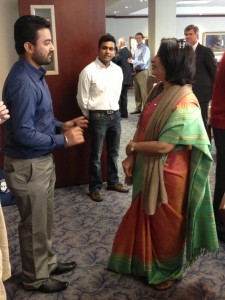
Nirupama Rao, ambassador of India to the United States, visited the David M. Kennedy Center for International Studies on Friday to discuss India and U.S. relations.
Rao began her remarks by discussing how India and the United States have used each other as models throughout their history.
“This is a relationship between two of the world’s most important democracies,” Rao said. “(It’s) a relationship that did not happen yesterday. Through the history of your nation and ours, there have been linkages that were established between the two countries. In fact, from the days before your independence, when you threw tea into the Boston Harbor … it was the same East India Company and the British government that you won your independence from, and then we fought much later and won our independence also.”
She went on to talk about how American poets have written about Indian culture and how Mahatma Gandhi’s philosophy corresponded with that of many American thinkers. Even Martin Luther King, Jr. went on to learn nonviolent resistance from Gandhi’s example.
“Our histories are very intertwined,” Rao said. “Even if the geographical distances may separate us, today we live in a very interconnected world.”
She explained that there is a growing Indian population in the United States, many of whom are distinguished members of society. There are three million people of Indian origin in America. According to Rao, at least 40 percent of those people hold graduate or doctorate degrees, while others have distinguished positions like governors and members of Congress.
Rao continued by explaining that India is the biggest democracy in the world and that more and more people are studying India, especially the political and economical aspects of the country.
“Every half percentile of growth that we are able to achieve in excess of what we (had) before translates into lifting so many millions of people,” she said.
Because India is responsible for such a large part of the world’s population, its citizens are constantly striving to improve. Rao said they are focusing on making India a fully developed country, alleviating poverty, educating young people and improving infrastructure. They have done a lot to move toward these goals, and America has a place to help as well.
“We need much more trade and engagement between ourselves. And investment. Investment is an imperative,” Rao explained. “(India) has become a mecca for research and innovation … but we need more U.S. investment in manufacturing because that’s where the jobs can be created for the millions of young people whose aspirations for the future are so big.”
Throughout the years, India and the U.S. have worked together. India supports the fight against terrorism. U.S. and Indian navies also cooperate to keep the oceans free from the threat of piracy and other dangers. India has procured more than $10 billion worth of weapons, aircraft and equipment from the United States.
“We exercise more with the United States forces than we do perhaps with any other country,” Rao said.
At the end of her remarks, the ambassador emphasized the positive relationship that the two countries maintain and how she looks forward to the future.
“The relationship is in a very good place today,” Rao said. “There is much more to be realized in terms of its potential, and each of you are an important part of this great enterprise.”




